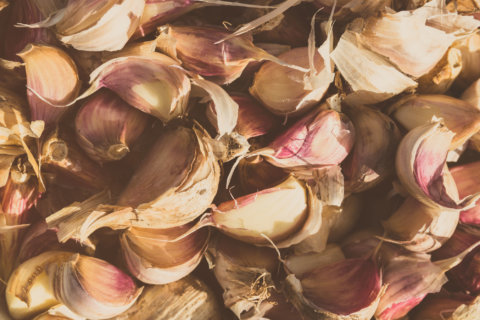Garlic harvest: First you cure, then you cull
Susan in Bethesda writes: “I harvested my garlic today and it looks great — it is now drying. How do I store it before I use it? And how exactly do I dry sliced garlic to make the garlic powder you always talk about?”
After harvest, the whole heads of garlic should be placed in a dry, airy spot to cure. Don’t expose them to direct sun or let them get wet. After a week, examine the harvest and immediately pull apart any damaged heads (i.e., ones with broken or split-open wrappers).
Cut off any damaged areas and use the remaining parts of the cloves to make a super-garlicky dinner that night. Sort undamaged cloves (even if they came from damaged heads) into two piles: large and small. Use the smallest ones when you need fresh garlic. Save the biggest cloves for replanting in early September.
Are your necks hard? Or soft?
How to store your garlic depends on which type of garlic you grew, Suzie. Softneck garlic — the “white,” “California” garlic that’s sold in supermarkets — likes to grow in warm weather and can be stored sitting out in the open (or hanging) in a dry, airy spot for many months, but it doesn’t like winter, and the flavor is bland.
Hardneck varieties — the Russian and Sicilian types with beautiful red and purple wrappers and fabulous flavors as well as the great Heirloom back stories — are superior in every way except storage; they will be sprouting by Thanksgiving. That’s why THIS is the time to work your harvest for a full year’s worth of sensational seasoning.
Keeping your powder dry
Here’s how to dry sliced garlic to make your own garlic powder:
Over this month and next, carefully break apart your heads into individual cloves. Save the biggest ones for replanting in early September, set smaller ones aside for long-term storage in the form of garlic powder.
Remove the wrappers from these smaller cloves, slice them up and place them in a food dryer for a few days. Then place the dried pieces in a brand-new coffee grinder (I bought mine at Kohl’s for $10 — and that was $10 of the Kohl’s “funny money” they use to keep you coming back) and whiz them up into a powder.
Store the powder in clean, dry spice jars with a few of those desiccating pouches that come packed with vitamins and running shoes in each jar. Homemade garlic powder puts store-bought to shame!
Has Bugs Bunny been bugging your begonias?
What’s been eating your garden this season? The usual deer, groundhogs, beetles and bugs — or has it been Bugs Bunny?
I received an email earlier in the week from a local print reporter, who writes: “I’ve heard rumblings that the rabbit population is ‘exploding’ in Northwest D.C. Do you know anything about an increasing rabbit population, or whether gardeners have seen increased problems with rabbits?”
I replied that we had done an entire week on rabbit control earlier in the season, and that with the extremely wet weather, we’ve experienced lots of lush green growth and thus a strong potential for rabbit proliferation. After all, they breed like … well, like rabbits, you know?
But what have you seen? Are rabbits ravishing your radishes? And is there an “explosion” in Northwest D.C.?
Inquiring minds want to know! So email your response to me at mikemcg@ptd.net.
How not to kill your lawn
Time for some timely reminders about summertime lawn care!
1) If you are watering your lawn right now, you are certifiable! Lawns need an inch of water a week — not an inch a day! Let your turf dry out completely between waterings to encourage deep root growth and to avoid death. Avoiding death is good.
2) Never cut your lawn when it’s wet or you will shred the blades, which will then be unable to hold water, leading to death. Again, avoiding death is good.
3) Never cut your lawn lower than 3 inches or it may not be able to collect enough solar energy to survive, leading to (all together now!) death.
4) Do not feed your lawn in the summer. Cool-season lawns of fescue and/or bluegrass are already stressed by summer heat and feeding them only makes things worse, especially if the food is a cheap, quick-release chemical fertilizer, which could lead to … well, you know.
Mike McGrath was editor-in-chief of Organic Gardening magazine from 1990 through 1997. He has been the host of the nationally syndicated public radio show “You Bet Your Garden” since 1998 and Garden Editor for WTOP since 1999. Send him your garden or pest control questions at MikeMcG@PTD.net.







